12. Long range regulation and insulation of domains
21.12 Long range regulation and insulation of domains |
| Key terms defined in this section |
| Domain of a chromosome may refer either to a discrete structural entity defined as a region within which supercoiling is independent of other domains; or to an extensive region including an expressed gene that has heightened sensitivity to degradation by the enzyme DNAase I. MAR (matrix attachment site; also known as SAR for scaffold attachment site) is a region of DNA that attaches to the nuclear matrix. |
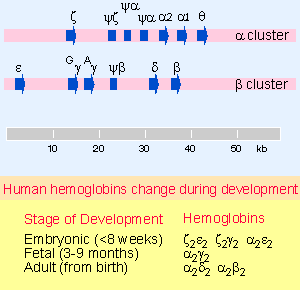 |
Figure 4.1 Each of the a-like and b-like globin gene families is organized into a single cluster that includes functional genes and pseudogenes (y. |
Some genes respond to additional regulatory elements as well as to promoters and enhancers. The existence of these elements was identified by the inability of a region of DNA including a gene and all known regulatory elements to be properly expressed when introduced into an animal as a transgene. The best characterized example is provided by the mouse β-globin cluster. Recall from Figure 4.1 that the α-globin and β-globin genes in mammals each exist as clusters of related genes, expressed at different times during embryonic and adult development. These genes are provided with a large number of regulatory elements, which have been analyzed in detail. In the case of the adult human β-globin gene, regulatory sequences are located both 5′ and 3′ to the gene and include both positive and negative elements in the promoter region, and additional positive elements within and downstream of the gene.
 |
Figure 21.22 A globin domain is marked by hypersensitive sites at either end. The group of sites at the 5 F side constitutes the LCR and is essential for the function of all genes in the cluster. |
But a human β-globin gene containing all of these control regions is never expressed in a transgenic mouse within an order of magnitude of wild-type levels. Some further regulatory sequence is required. Regions that provide the additional regulatory function are identified by DNAase I hypersensitive sites that are found at the ends of the cluster. The map of Figure 21.22 shows that the 20 kb upstream of the ε-gene contains a group of 5 sites; and there is a single site 30 kb downstream of the β-gene. Transfecting various constructs into mouse erythroleukemia cells shows that sequences between the individual sites in the 5′ region can be removed without much effect, but that removal of any of the sites reduces the overall level of expression.
The 5′ regulatory sites are the primary regulators, and the cluster of hypersensitive sites is called the LCR (locus control region). We do not know whether the 3′ site has any function. The LCR is absolutely required for expression of each of the globin genes in the cluster. Each gene is then further regulated by its own specific controls. Some of these controls are autonomous: expression of the ε- and γ-genes appears intrinsic to those loci in conjunction with the LCR. Other controls appear to rely upon position in the cluster, which provides a suggestion that gene order in a cluster is important for regulation (615).
 |
Figure 19.42 Sensitivity to DNAase I can be measured by determining the rate of disappearance of the material hybridizing with a particular probe. |
The entire region containing the globin genes, and extending well beyond them, constitutes a chromosomal domain. It shows increased sensitivity to digestion by DNAase I (see Figure 19.42). Deletion of the 5′ LCR restores normal resistance to DNAase over the whole region. It is possible that the LCR is required to "open up" the whole domain and make it available for transcription.
Does this model apply to other gene clusters? The α-globin locus has a similar organization of genes that are expressed at different times, with a group of hypersensitive sites at one end of the cluster, and increased sensitivity to DNAase I throughout the region. Only a small number of other cases are known in which an LCR controls a group of genes.
Does a domain have a discrete boundary that marks its end; or do effects emanating from discrete points within it decline gradually at the ends of the region?
Elements that prevent the passage of activating or inactivating effects are called insulators. When an insulator is placed between an enhancer and a promoter, it prevents the enhancer from activating the promoter. This may explain how the action of an enhancer is limited to a particular promoter. When an insulator is placed between an active gene and heterochromatin, it protects the gene against the inactivating effect that spreads from the heterochromatin. All known insulators possess both these properties, suggesting that they affect the general organization of chromatin.
The leftmost hypersensitive site of the chick β-globin LCR (HS4) is an insulator that marks the 5′ end of the functional domain. HS4 lies within a 250 bp region that has the properties of an (unmethylated) CpG island (although it is not associated with a promoter). We do not know yet what identifies the other end of the domain (705).
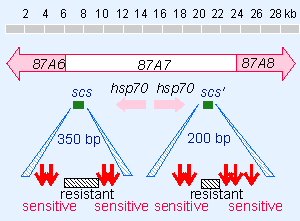 |
Figure 21.23 Specialized chromatin structures that include hypersensitive sites mark the ends of a domain in the D. melanogaster genome and insulate genes between them from the effects of surrounding sequences. |
The first information about the delineation of domains was provided by the analysis of D. melanogaster genes summarized in Figure 21.23. Two genes for the protein Hsp70 lie within an 18 kb region that constitutes band 87A7. Special structures, called scs and scs′ (specialized chromatin structures, are found at the ends of the band. Each consists of a region that is highly resistant to degradation by DNAase I, flanked on either side by hypersensitive sites, spaced at about 100 bp. The cleavage pattern at these sites is altered when the genes are turned on by heat shock.
The scs elements insulate the hsp70 genes from the effects of surrounding regions. If we take scs units and place them on either side of a white gene, the gene can function anywhere it is placed in the genome, even in sites where it would normally be repressed by context, for example, in heterochromatic regions (703).
The scs units do not seem to play either positive or negative roles in controlling gene expression, but just restrict effects from passing from one region to the next. If adjacent regions have repressive effects, however, the scs elements might be needed to block the spread of such effects, and therefore could be essential for gene expression. In this case, deletion of such elements could eliminate the expression of the adjacent gene(s).
 |
Figure 21.24 A protein that binds to the insulator scs F is localized at interbands in Drosophila polytene chromosomes. Red staining identifies the DNA (the bands) on both the upper and lower samples; green staining identifies BEAF32 (often at interbands) on the upper sample. Yellow shows coincidence of the two labels. Some of the more prominent stained interbands are marked by white lines. Photograph kindly provided by Uli Laemmli. |
The generality of this type of element is indicated by the properties of a protein, BEAF-32, that binds to scs′. It shows discrete localization within the nucleus, but the most remarkable data derive from its localization on polytene chromosomes. Figure 21.24 shows that an anti-BEAF-32 antibody stains ~50% of the interbands of the polytene chromosomes. This suggests indeed that the band is a functional unit, and that elements in the interbands prevent activating or inactivating effects from propagating from one band to the next.
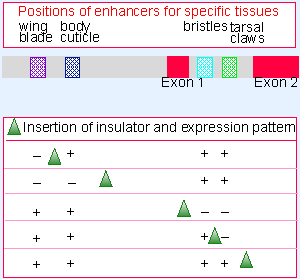 |
Figure 21.25 The insulator of the gypsy transposon blocks the action of an enhancer when it is placed between the enhancer and the promoter. |
Insulators may have directional properties. Insertions of the transposon gypsy into the yellow (y) locus of D. melanogaster cause loss of gene function in some tissues, but not in others. The reason is that the y locus is regulated by four enhancers , as shown in Figure 21.25. Wherever gypsy is inserted, it blocks expression of all enhancers that it separates from the promoter. The sequence responsible for this effect is an insulator that lies at one end of the transposon. The insulator works irrespective of its orientation of insertion.
Some of the enhancers are upstream of the promoter and others are downstream, so the effect cannot depend on position with regard to the promoter, nor can it require transcription to occur through the insulator. This is difficult to explain in terms of looping models for enhancer-promoter interaction, which essentially predict the irrelevance of the intervening DNA. The obvious model to invoke is a tracking mechanism, in which some component must move unidirectionally from the enhancer to the promoter, but this is difficult to reconcile with previous characterizations of the independence of enhancers from such effects.
Proteins that act upon the insulator have been identified through the existence of two other loci that affect insulator function in a trans-acting manner. Mutations in su(Hw) abolish insulation: y is expressed in all tissues in spite of the presence of the insulator. This suggests that su(Hw) codes for a protein that recognizes the insulator and is necessary for its action. Su(Hw) is a nuclear protein; mapping to polytene chromosomes shows that it is bound at a large number of sites. The insulator contains 12 binding sites for su(Hw); it is not known how many are required for its action (706, 709).
The second locus is mod(mdg4), in which mutations have the opposite effect. This is observed by the loss of directionality. These mutations increase the effectiveness of the insulator by extending its effects so that it blocks utilization of enhancers on both sides. su(Hw) is epistatic to mod(mdg4); this means that in a double mutant we see only the effect of su(Hw). This implies that mod(mdg4) acts through su(Hw). The basic role of the wild-type protein from the mod(mdg4) locus is therefore to impose directionality on the ability of su(Hw) to insulate promoters from the boundary.
Binding of su(Hw) to DNA, followed by binding of mod(mdg4) to su(Hw), therefore creates a unidirectional block to activation of a promoter. This suggests that the insulator bound by su(Hw) can spread inactivity in both directions, but mod(mdg4) stops the effect from spreading in one direction. Perhaps thereis some intrinsic directionality to chromatin, which results ultimately in the incorporation of su(Hw), mod(mdg4), or some other component in one orientation, presumably by virtue of an interaction with some component of chromatin that is itself preferentially oriented. Any such directionality would need to reverse at the promoter.
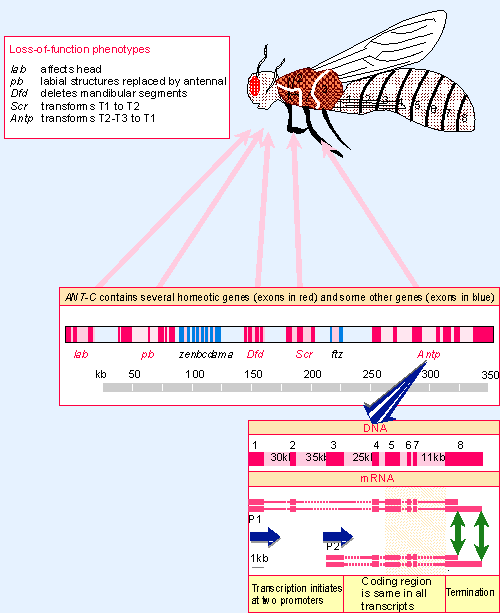 |
Figure 29.32 The homeotic genes of the ANT-C complex confer identity on the most anterior segments of the fly. The genes vary in size, and are interspersed with other genes. The antp gene is very large and has alternative forms of expression. |
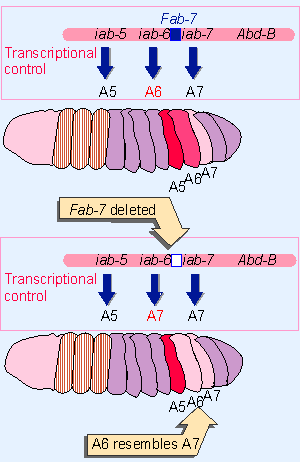 |
Figure 21.26 Fab-7 is a boundary element that is necessary for the independence of regulatory elements iab-6 and iab-7. |
Sometimes elements with different cis-acting properties are combined to generate regions with complex regulatory effects. The Fab-7 region is defined by deletions in the bithorax locus of Drosophila. This locus contains a series of cis-acting regulatory elements that control the activities of three transcription units (see Figure 29.32). The relevant part of the locus is drawn in Figure 21.26. The regulatory elements iab-6 and iab-7 control expression of the adjacent gene Abd-B in successive regions of the embryo (segments A6 and A7). A deletion of Fab-7 causes A6 to develop like A7, instead of in the usual way. This is a dominant effect, which suggests that iab-7 has taken over control from iab-6. We can interpret this in molecular terms by supposing that Fab-7 provides a boundary that prevents iab-7 from acting when iab-6 is usually active (707, 708).
Like other boundary elements, Fab-7 contains a distinctive chromatin structure that is marked by a series of hypersensitive sites. The region can be divided into two types of element by smaller deletions and by testing fragments for their ability to provide a boundary. A sequence of ~3.3 kb behaves as an insulator when it is placed in other constructs. A sequence of ~0.8 kb behaves as a repressor that acts on iab-7. The presence of these two elements explains the complicated genetic behavior of Fab-7 (which we have not described in detail).
An insight into the action of the boundary element is provided by the effects of substituting other insulators for Fab-7. The effect of Fab-7 is simply to prevent interaction between iab-6 and iab-7. But when an Su(Hw) binding site is introduced, a stronger effect is seen: iab-5 takes over from iab-7. And when an scs element is used, the effect extends to iab-4. This suggests a scheme in which stronger elements can block the actions of regulatory sequences that lie farther away.
This conclusion introduces a difficulty for explaining the action of boundary elements. They cannot be functioning in this instance simply by preventing the transmission of effects past the boundary. This argues against models based on simple tracking or inhibiting the linear propagation of structural effects. It suggests that there may be some sort of competitive effect, in which the strength of the element determines how far its effect can stretch.
The situation is further complicated by the existence of anti-insulator elements, which allow an enhancer to overcome the blocking effects of an insulator (940). This again suggests that these effects are mediated by some sort of control over local chromatin structure.
 |
Figure 21.27 Domains may possess three types of sites: insulators to prevent effects from spreading between domains; MARs to attach the domain to the nuclear matrix; and LCRs that are required for initiation of transcription. |
If we now put together the various types of structures that have been found in different systems, we can think about the possible nature of a chromosomal domain. Figure 21.27 summarizes the structures that might be involved in defining a domain. A domain (perhaps this might be a band in the case of Drosophila) might contain several transcription units. The LCR itself is an essential structure whose function at a distance is essential for the ability of any and all genes in a domain to be expressed. Several types of cis-acting structures could be required for function. As defined originally, the property of the LCR rests with an enhancer-like hypersensitive site that is needed for the full activity of promoter(s) within the domain. An insulator may stop activating or repressing effects spreading beyond the functional unit. A matrix attachment site (MAR) may be responsible for physical attachment to a site on the nuclear periphery. These elements might be found at one end or at both ends of a domain.
Perhaps this type of organization could also help to explain the large size of the genome. A certain amount of space could be required for such a structure to operate, for example, to allow chromatin to become decondensed and to become accessible. Although the exact sequences of much of the unit might be irrelevant, there might be selection for the overall amount of DNA within it, or at least selection might prevent the various transcription units from becoming too closely spaced.
This section updated 1-24-2000
| Research | |
| 615: | van Assendelft, G. B., Hanscombe, O., Grosveld, F., and Greaves, D. R. (1989). The b-globin dominant control region activates homologous and heterologous promoters in a tissue-specific manner. Cell 56, 969-977. |
| 703: | Kellum, R. and Schedl, P. (1991). A position-effect assay for boundaries of higher order chromosomal domains. Cell 64, 941-950. |
| 705: | Chung, J. H., Whiteley, M., and Felsenfeld, G. (1993). A 5?/FONT> element of the chicken ß-globin domain serves as an insulator in human erythroid cells and protects against position effect in Drosophila. Cell 74, 505-514. |
| 706: | Roseman, R. R., Pirrotta, V., and Geyer, P. K. (1993). The su(Hw) protein insulates expression of theD. melanogaster white gene from chromosomal position-effects. EMBO J. 12, 435-442. |
| 707: | Hagstrom, K., Muller, M., and Schedl, P. (1996). Fab-7 functions as a chromatin domain boundary to ensure proper segment specification by the Drosophila bithorax complex. Genes Dev. 10, 3202-3215. |
| 708: | Mihaly, J. et al. (1997). In situ dissection of the Fab-7 region of the bithorax complex into a chromatin domain boundary and a Polycomb-response element. Development 124, 1809-1820. |
| 709: | Harrison, D. A., Gdula, D. A., Cyne, R. S., and Corces, V. G. (1993). A leucine zipper domain of the suppressor of hairy-wing protein mediates its repressive effect on enhancer function Genes Dev. Genes Dev. 7, 1966-1978. |
| 940: | Zhou, J. and Levine, M. (1999). A novel cis-regulatory element, the PTS, mediates an anti-insulator activtity in the Drosophila embryo.. Cell 99, 567-575. |